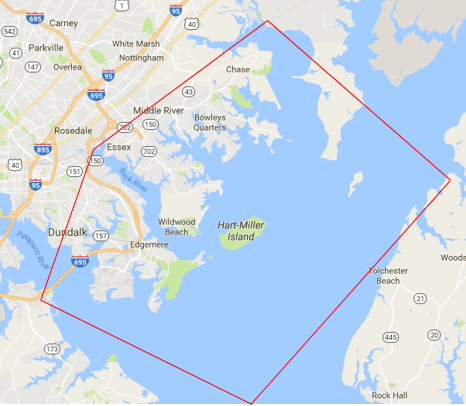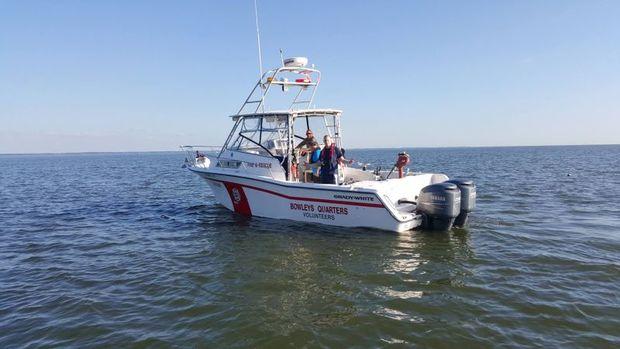
Each year there are thousands of motor, sailing, and personal watercraft vessels that for recreational purposes, enjoy the waterways of the Maryland Chesapeake Bay and its tributaries. Have you ever wondered though - what happens when an emergency happens on the open water? If you’re located on the waters of the upper Chesapeake Bay, chances are
Marine Emergency Team 21 (MET21) of the Bowleys Quarters Volunteer Fire Department will be involved in helping you.
Comprised of 35 specially-trained response personnel, two Marine Fire/Rescue vessels, three shallow draft boats, one inflatable craft, and several land-based response/towing vehicles, the Bowleys Quarters Volunteer Fire Department operates the largest Marine Emergency Team in the Upper Bay area. MET21 is one of few teams north of the Chesapeake Bay Bridge that can make year-round emergency responses in any weather condition.
Team personnel are trained for all worst-case scenarios that they may be faced with. Common responses include vessel fires, collisions, hazardous material incidents, and medical emergencies. Two of their vessels can provide Basic Life Support and when staffed by EMT’s, are essentially ambulances on the water.
MET21’s primary response area covers 85 square miles of open water in the upper Chesapeake Bay and includes all of Baltimore County’s waterfront communities. Secondary responses include mutual aid requests by Harford, Anne Arundel, Kent, Queens Anne, and Cecil Counties, as well as Baltimore City.
The team also often works with all commercial tow vessels in the area. Supporting MET21’s response are other agencies such as Natural Resources Police, Baltimore County Marine Police, Aberdeen Proving Ground police and fire, Kent County Fire Department, North Point-Edgemere Volunteer Fire Company, and the USCG.
[gallery link="file" columns="4" ids="18319,18318,18320,18321"]
MET21 By the Numbers:
Primary Area of Responsibility
- 90 square miles of tidal waters
- 5 major peninsulas
- 6 rivers
- 175 miles of coastline
- 47 marinas, yacht clubs, or boatyards
- 15,807 slips and 760 dry racks
- 7 public boat ramps
Vessels
- Boat 216: 18-foot flat bottom boat used primarily to transport personnel and equipment from shore to incident site.
- Marine Unit 217: 23-foot Jones Brothers center console has a fire pump and hose, thermal imaging capabilities, and basic life support.
- Marine Unit 219: 30-foot Grady White, the largest vessel of the MET21 fleet. Primary response unit for larger fires and patient transport.
- Flood Evacuation 214-A and 218-A: 14-foot flat bottom boat used for transporting people in flood waters and for deploying harbor booms after a hazardous material spill.
- Oceanid Rapid Deployment Craft (RDC): versatile, safe, and easy to use inflatable craft. Specifically designed for water rescue.
- Special Unit 214: 2004 Dodge pickup, primary tow vehicle for Marine Unit 217 in the winter season and Boat 216 year-round.

Response Operations
- 35 highly-trained members (100% volunteer)
- over 400 man-hours annually
- average of 67 multi-unit responses annually
- free service
Funding
- average service life for a marine rescue vehicle: 10 years
- $150-$250K in average replacement costs
- $0 available from the DNR Waterway Improvement Fund
- $0 available from federal Fire Act Grant
- Less than 50% of local marinas make donations
Click here to learn more about MET21 and to make a donation.
 Each year there are thousands of motor, sailing, and personal watercraft vessels that for recreational purposes, enjoy the waterways of the Maryland Chesapeake Bay and its tributaries. Have you ever wondered though - what happens when an emergency happens on the open water? If you’re located on the waters of the upper Chesapeake Bay, chances are Marine Emergency Team 21 (MET21) of the Bowleys Quarters Volunteer Fire Department will be involved in helping you.
Comprised of 35 specially-trained response personnel, two Marine Fire/Rescue vessels, three shallow draft boats, one inflatable craft, and several land-based response/towing vehicles, the Bowleys Quarters Volunteer Fire Department operates the largest Marine Emergency Team in the Upper Bay area. MET21 is one of few teams north of the Chesapeake Bay Bridge that can make year-round emergency responses in any weather condition.
Team personnel are trained for all worst-case scenarios that they may be faced with. Common responses include vessel fires, collisions, hazardous material incidents, and medical emergencies. Two of their vessels can provide Basic Life Support and when staffed by EMT’s, are essentially ambulances on the water.
MET21’s primary response area covers 85 square miles of open water in the upper Chesapeake Bay and includes all of Baltimore County’s waterfront communities. Secondary responses include mutual aid requests by Harford, Anne Arundel, Kent, Queens Anne, and Cecil Counties, as well as Baltimore City.
The team also often works with all commercial tow vessels in the area. Supporting MET21’s response are other agencies such as Natural Resources Police, Baltimore County Marine Police, Aberdeen Proving Ground police and fire, Kent County Fire Department, North Point-Edgemere Volunteer Fire Company, and the USCG.
[gallery link="file" columns="4" ids="18319,18318,18320,18321"]
Each year there are thousands of motor, sailing, and personal watercraft vessels that for recreational purposes, enjoy the waterways of the Maryland Chesapeake Bay and its tributaries. Have you ever wondered though - what happens when an emergency happens on the open water? If you’re located on the waters of the upper Chesapeake Bay, chances are Marine Emergency Team 21 (MET21) of the Bowleys Quarters Volunteer Fire Department will be involved in helping you.
Comprised of 35 specially-trained response personnel, two Marine Fire/Rescue vessels, three shallow draft boats, one inflatable craft, and several land-based response/towing vehicles, the Bowleys Quarters Volunteer Fire Department operates the largest Marine Emergency Team in the Upper Bay area. MET21 is one of few teams north of the Chesapeake Bay Bridge that can make year-round emergency responses in any weather condition.
Team personnel are trained for all worst-case scenarios that they may be faced with. Common responses include vessel fires, collisions, hazardous material incidents, and medical emergencies. Two of their vessels can provide Basic Life Support and when staffed by EMT’s, are essentially ambulances on the water.
MET21’s primary response area covers 85 square miles of open water in the upper Chesapeake Bay and includes all of Baltimore County’s waterfront communities. Secondary responses include mutual aid requests by Harford, Anne Arundel, Kent, Queens Anne, and Cecil Counties, as well as Baltimore City.
The team also often works with all commercial tow vessels in the area. Supporting MET21’s response are other agencies such as Natural Resources Police, Baltimore County Marine Police, Aberdeen Proving Ground police and fire, Kent County Fire Department, North Point-Edgemere Volunteer Fire Company, and the USCG.
[gallery link="file" columns="4" ids="18319,18318,18320,18321"]
